Jain sculpture
| Part of a series on |
| Jainism |
|---|
 |
|
Jain prayers |
|
Ethics |
|
Major sects |
|
Festivals |
|
|
Jain sculptures or Jain idols are the images depicting Tirthankaras (teaching gods). These images are worshiped by the followers of Jainism. The sculpture can depict any of the twenty-four tirthankaras with images depicting Parshvanatha, Rishabhanatha, or Mahāvīra being more popular. Jain sculptures are an example of Jain art.[1][2] There is a long history of construction of Jain sculptures. Early examples include Lohanipur Torsos which has been regarded to be from the Maurya period,[3] and images from the Kushan period from Mathura.[4]
Iconography
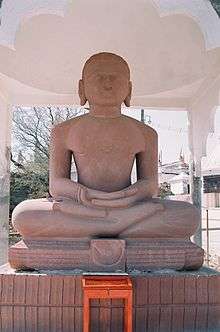
The Jain idols are males depicted in both sitting and standing postures.[5] The tīrthaṅkaras are represented either Padmasana (seated in yoga posture) or standing in the Kayotsarga posture.[6] Parshvanatha statues are usually depicted with a snake crown on head, Bahubali statues are usually depicted covered with creepers.[7] However, there are a few differences in Digambara and Svetambara depiction of idols.[5] Digambara images are naked without any beautification whereas Svetambara ones are clothed and decorated with temporary ornaments.[5]
Examples
Giant rock-cut statues of Jain Tirthankaras are carved in the Gopachal Hill, Gwalior, Madhya Pradesh. [8][9]
Charans are footprints exclusive to Jain temples. The charan of Tirthankara Rishabhanatha are present at the Badrinath Temple.
In Tamil Nadu
Jainism spread here and there all over Tamil Nadu during Sangam Age. One of the Tamil literature, called Paripadal (பரிபாடல்), probably belongs to 3rd century, mentions that there were propelling statues sculptured in stone for different deities in the temple of God Murugan in Thirupparankundram. One among them was Jain statue. Others are Kaaman-Rathi (the deities of Love), Deity Indira (the king of so-called Heavenly people according to Indian mythology), Agaligai (wife of Saint Gaudham), and Buddha.
Jain sculptures in Kalugumalai near Madurai belongs to one century latter is to be compared with Thirpparankunram Jain sculpture. In addition a propelling stone statue of a Jain monk mentioned in Tamil literature is also present. Cave inscriptions in Brahmi script of Chera kings in Pugalur probably one century earlier to that of the literature we have taken to our consideration, names some of the Jain Monks vs Yatrur Senkayapan, Pittan, Kotran. Pittan and Kotran are the chieftains of Tamil Nadu also mentioned in Tamil literature more or less to the same period.
In museums
Lohanipur torso found in a central Division of Patna, ancient Pataliputra, dates back to 3rd century BCE.[10] Some of the oldest Jain sculptures excaved at Kankali Tila are in the Government Museum, Mathura.[11] Many Jain sculptures are kept in Government Museum, Chennai.[12][13]
The oldest Jain sculpture in the Metropolitan Museum of Art in New York is of the Siddha Bahubali.[14]
Jain vs Buddhist iconography
A Buddhist image can be in one of several mudras. However the Jain tirthankara images can only be in one of the two format. In Padmasana, the statutes of a Jina and a Buddha can be similar. The Buddha statue has folds of the cloth on the upperbody, with cloth behind the left arm, where as the Jina statue is without clothes, unless it is a Shwetambara image which shows a fan-like dhoti folds.
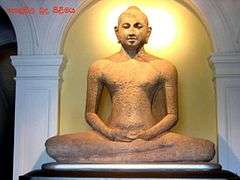 Toluvila statue Buddha from Anuradhapura, 5th Century CE, Colombo
Toluvila statue Buddha from Anuradhapura, 5th Century CE, Colombo- Rishabhanatha 5th Century CE, from Kankali Tila
Chronological Gallery: Kayotsarga Statues
- Four Fold Jain Image 1st Century Kankali Tila Mathura

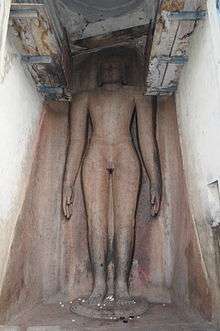
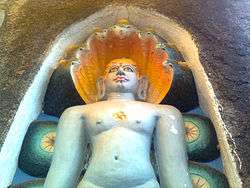 Converted image of Parshvanatha
Converted image of Parshvanatha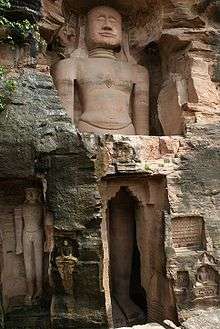
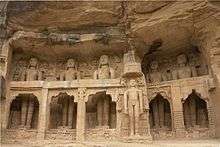
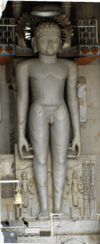
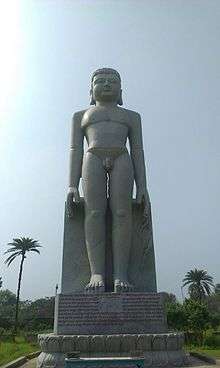 31 ft statue of Lord Vasupujya at Champapur, Bhagalpur
31 ft statue of Lord Vasupujya at Champapur, Bhagalpur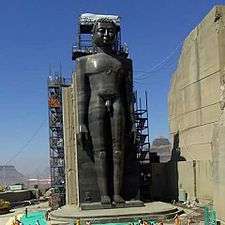
Chronological Gallery: Padmasana Statues,
- Ayagapatta, 1st Century CE Kankali Tila Mathura
)%2C_Parshvanatha%2C_Neminatha%2C_and_Mahavira)_LACMA_M.85.55_(1_of_4).jpg) Rishabhanatha, Parshvanatha, Neminatha, and Mahavira, LACMA, Uttar Pradesh, circa 600
Rishabhanatha, Parshvanatha, Neminatha, and Mahavira, LACMA, Uttar Pradesh, circa 600- Parshvanatha, 600-700
.jpg) Parsvanatha 9th C, Akota Bronzes
Parsvanatha 9th C, Akota Bronzes- Rishabhanatha, 800-900
- Svetambara Tirthankara, 1000-1050 ca.
 Lord Adinath, Jain Center of New Jersey, modern
Lord Adinath, Jain Center of New Jersey, modern , Mumbai Shwetambar temple, modern
, Mumbai Shwetambar temple, modern
See also
Notes
- ↑ "Jainism".
- ↑ Asia Society: The Collection In Context
- ↑ Indian Sculpture: Circa 500 B.C.-A.D. 700, Volume 1 of Indian Sculpture: A Catalogue of the Los Angeles County Museum of Art Collection, Pratapaditya Pal, Los Angeles County Museum of Art, University of California Press, 1986 p. 22
- ↑ Dalal, Roshen (18 April 2014). "The Religions of India: A Concise Guide to Nine Major Faiths". Penguin UK. Retrieved 15 January 2018 – via Google Books.
- 1 2 3 Cort 2010.
- ↑ Zimmer 1953, p. 209-210.
- ↑ Pereira 1977, p. 9.
- ↑ worldvisitguide.com
- ↑ Jain sculptures in Gwalior - Abiyoyo
- ↑ Olivelle 2006, p. 399.
- ↑ Das 1980, p. 171.
- ↑ "Government Museum Chennai".
- ↑ "Government Museum Chennai".
- ↑ "Jain Siddha Bahubali, Entwined with Forest Vines". The Met’s Heilbrunn Timeline of Art History.
References
- Pereira, José (1977), Monolithic Jinas, Motilal Banarsidass, ISBN 0-8426-1027-8
- Cort, John E. (2010) [1953], Framing the Jina: Narratives of Icons and Idols in Jain History, Oxford University Press, ISBN 978-0-19-538502-1
- Zimmer, Heinrich (1953), Joseph Campbell, ed., Philosophies of India, London, E.C. 4: Routledge & Kegan Paul Ltd, ISBN 978-81-208-0739-6
- Olivelle, Patrick (2006). Between the Empires: Society in India 300 BCE to 400 CE. Oxford University Press. p. 399. ISBN 9780199775071.
- Das, Kalyani (1980), Early Inscriptions of Mathurā
External links
| Wikimedia Commons has media related to Jain sculptures. |